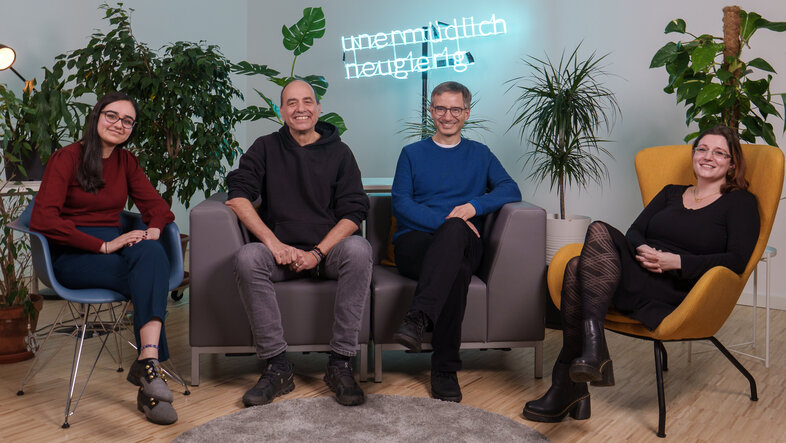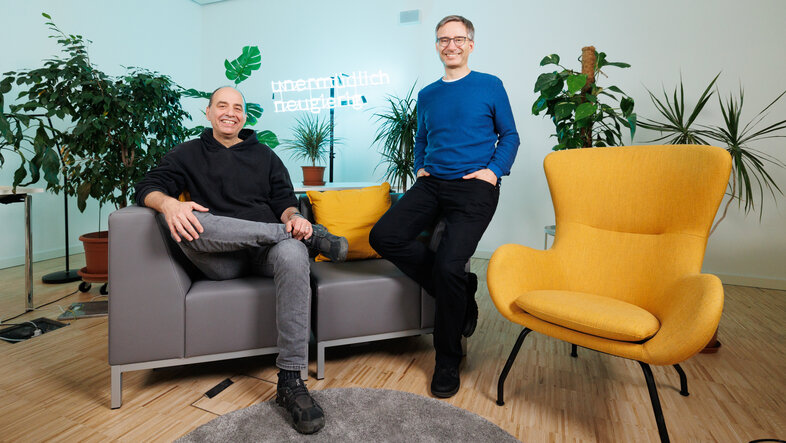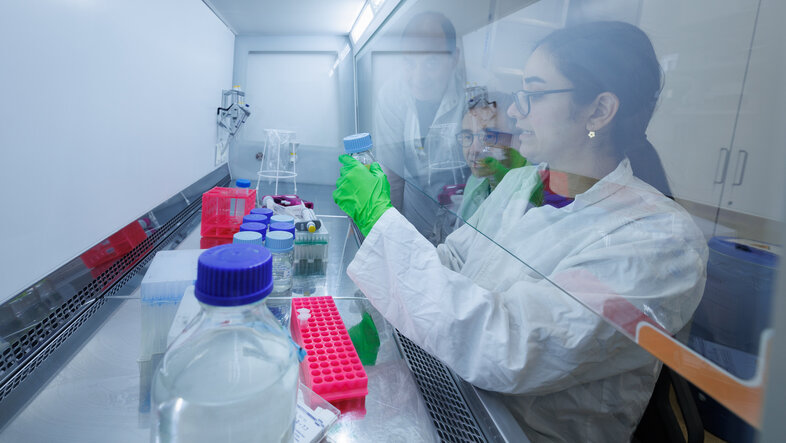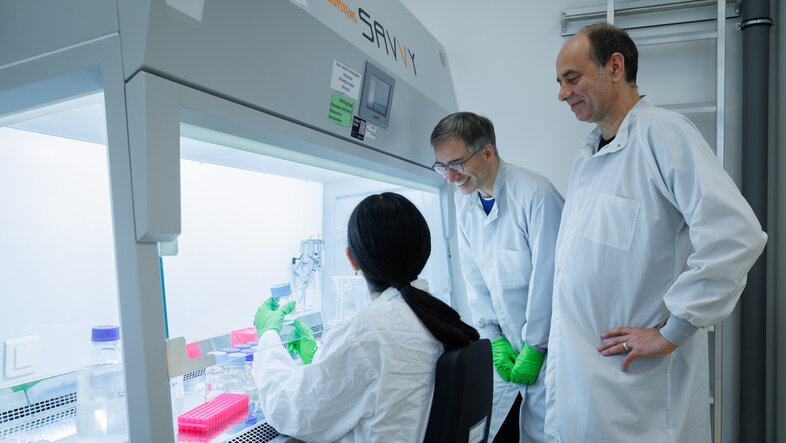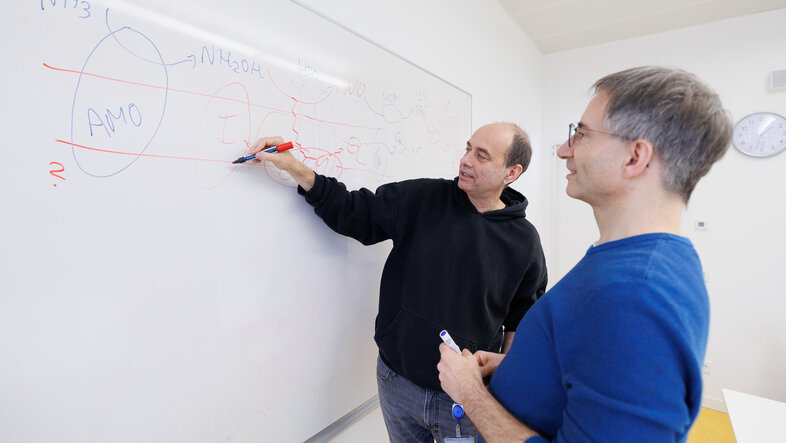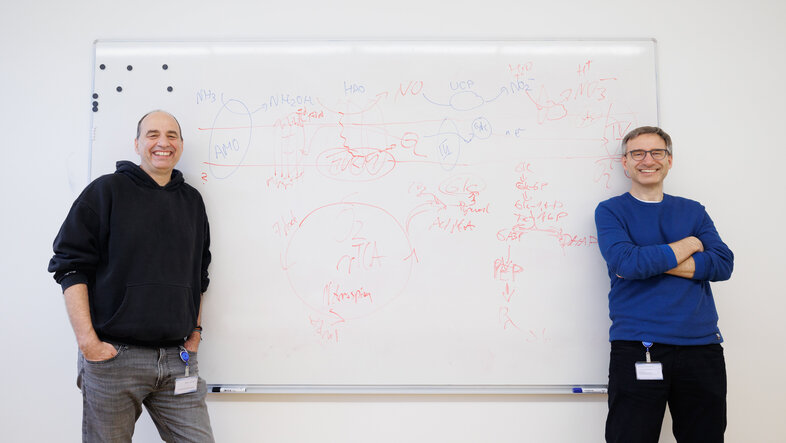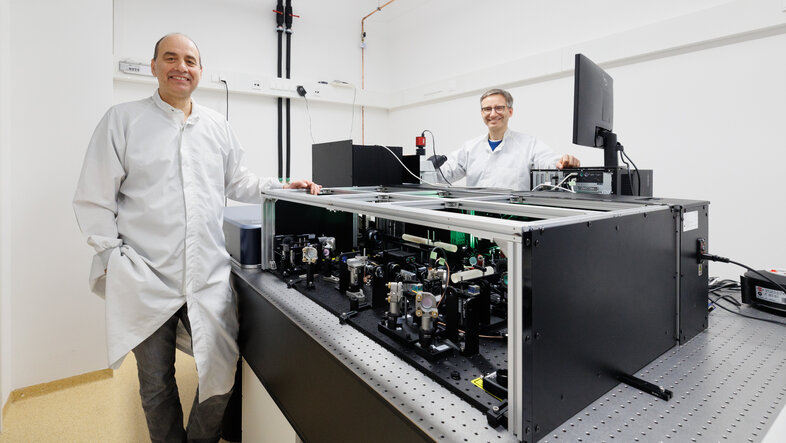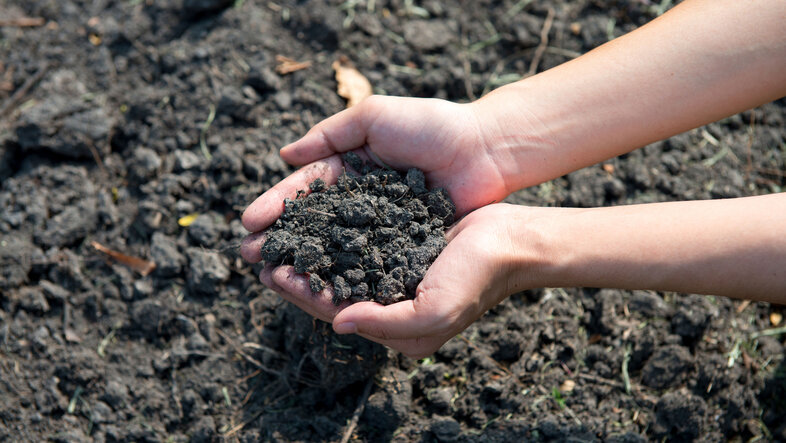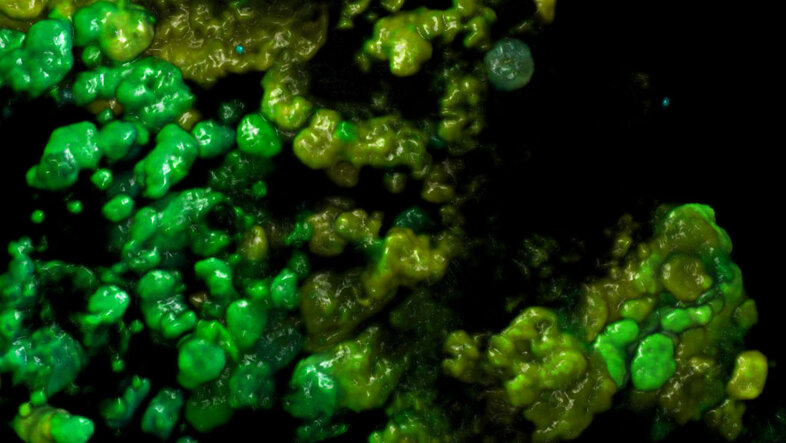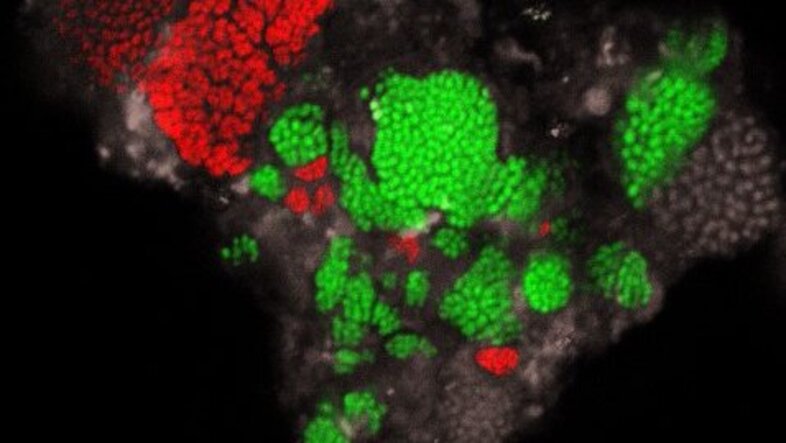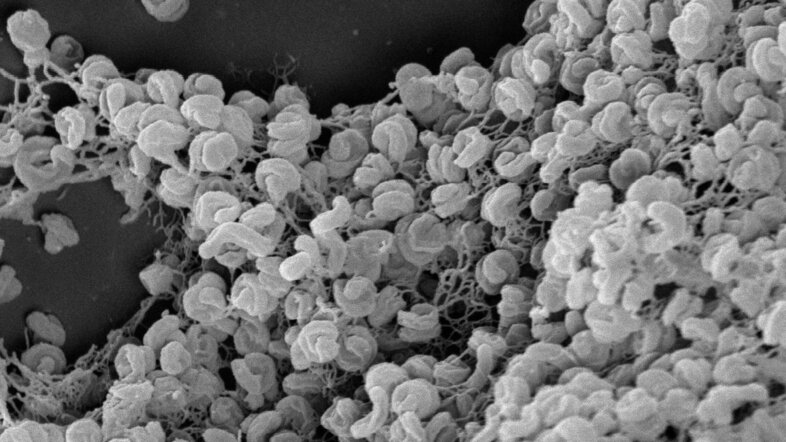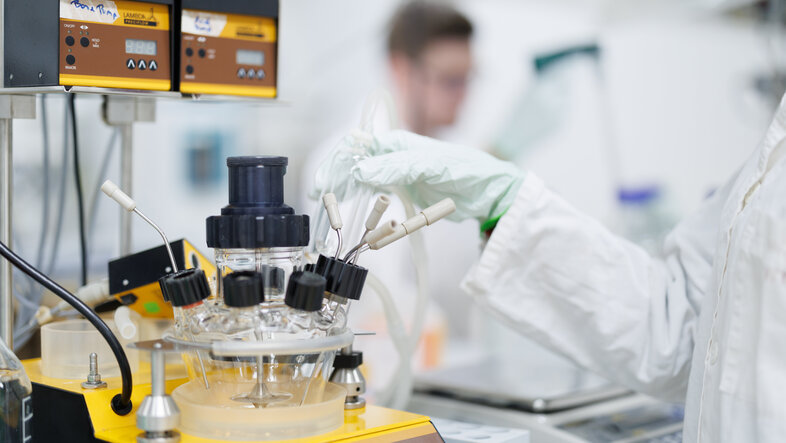Research for the next nitrogen revolution
Sarah Al-Ajeel, wearing bright green rubber gloves, is handling bacterial cultures. She is taking care of her "demanding friends", as the young microbiologist puts it, "May I introduce the comammox, a type of nitrifying bacteria. Favourite dish? Ammonia".
Even though they are smaller than a micrometre, these organisms require the doctoral candidate's undivided attention. "They are growing slowly and we have to take care that they are not contaminated with other bacteria." Small and not exactly low maintenance, the comammox shows great potential: these microbes that live on ammonia could play a key role in combating a global nitrogen crisis.
Video: Meet the scientists
No life without bacteria
Microorganisms: They are the focus of attention at the Centre for Microbiology and Environmental Systems Science (CeMESS) of the University of Vienna, where Sarah Al-Ajeel conducts research for her PhD as part of an international team led by microbiologists Holger Daims and Michael Wagner. In fact, the entire world revolves around these tiny organisms, we just fail to notice them for the most part (or only when they infect us, for example, when streptococcus causes "strep throat").
Microbes are main drivers of all major element cycles on the planet and play a key role in almost every function of the ecosystem. They are everywhere – for example, several thousand species of bacteria live in only one gramme of potting soil. Several hundred different strains can be found in the human gut. "Microorganisms were the first living organisms on our planet. We all carry their traces in every individual cell of our bodies. We could not exist without them," Holger Daims puts the significance of the tiny organisms in a nutshell.
Michael Wagner, his research colleague for many years and group leader at the Centre as well as its founding director, nods. "Once you've learnt to look at the world from a microbial perspective, you enter a parallel universe of sorts," he grins, describing the fascination that he and Holger Daims have shared for decades.
A world of its own: About microbes and those investigating them
Visiting the Division of Microbial Ecology, in short DOME, at the new University of Vienna Biology Building (UBB) in St. Marx, Vienna, is almost like entering a parallel universe, too. This is where, Al-Ajeel, Daims, Wagner and their team members – together with billions of microorganisms – spend a large part of their everyday life. Their working atmosphere is best described as extremely relaxed and super busy at the same time, with team members as familiar with each other as they are professional. The different research groups share everything – ranging from their ideas to the laboratory workplace and to the most expensive research equipment – regardless of the funding source. "In mutual cooperation", as the researchers put it in 'microbiology speak'.
In the middle of the busy, bustling humans and microorganisms, we arranged a meeting to discuss the topic of nitrogen with Daims, Wagner and their colleague Petra Pjevac, group leader and part of the 'Microbiome Family' at DOME since 2015. Why do we need it so urgently and why is so much of it circulating at the same time? What role do microorganisms play and what has changed since human's massive interference in the natural nitrogen cycle due to the industrial use of fertilisers? Most importantly, what needs to change to secure the provision of food for the world's population without harming planetary health in the long term? We have brought along many questions. And we have come to exactly the right place to find answers.
Microbiome for a sustainable future
"Microbiomes Drive Planetary Health": Under this motto, 30 scientists led by microbiologist Michael Wagner from the University of Vienna pooled their competences together. As a team, they aim to understand how microbiomes – communities of tiny microorganisms – regulate planetary health. With their ambitious project, the team was currently able to succeed in the competitive Clusters of Excellence-Programm of the Austrian Science Fund (FWF).
"We are intent on jointly addressing some of the most pressing questions regarding planetary health from the perspective of the microbiome." (Michael Wagner)
The University of Vienna cooperates in the platform with the Austrian Institute of Technology (AIT), the Institute of Science and Technology Austria (ISTA), the Medical University of Graz, the Austrian Academy of Sciences with the Research Center for Molecular Medicine (CeMM), the TU Vienna and the Johannes Kepler University Linz.
From a lack of nitrogen to an abundance of nitrogen
Every living organism, including humans, needs nitrogen to grow. While our atmosphere is full of it (78 per cent of the atmosphere consists of gaseous nitrogen), most organisms cannot use it in this form. To make use of this rare elixir of life, organisms have become resourceful in the course of evolution. Microorganisms play a key role in the process: They convert the nitrogen gas from the atmosphere into forms that humans, animals and plants can use.
At the beginning of the 20th century, humans managed to make atmospheric nitrogen usable, thus massively interfering with the nitrogen cycle: Our intensive livestock farming and use of synthetic fertilisers today brings more reactive nitrogen compounds to the world than all natural processes in the seas or on land.
Haber-Bosch: The 'first' nitrogen revolution
These developments were fostered by a chemical process which enables us to produce synthetic nitrogen fertilisers from atmospheric nitrogen. The so-called 'Haber-Bosch process' has revolutionised our agriculture and now enables us to feed more than 40 per cent of the global population. Today, we are reliant on synthetic nitrogen fertilizers.
But there is a drawback. Vast amounts of energy are required to convert atmospheric nitrogen into reactive nitrogen, yet we cast the latter like pearls before swine. "The use of synthetic fertilisers is extremely inefficient," explains Holger Daims. "Not even half of the nitrogen that we are using to fertilise our fields is actually used by the crops. The rest is lost to the atmosphere or is leaching from the soil into the ground water."
This is the starting point of a vicious cycle, with far-reaching consequences for the health of our planet, yet it is also where the invisible players from the world of microorganisms, the focus of our interview partners, come into play: the so-called 'nitrifying' bacteria and archaea.
It is madness how much energy we use to produce fertilisers for our crop plants which – due to fertiliser losses – ultimately over-fertilise our seas.
Michael Wagner
Tiny but powerful players in the nitrogen cycle
Nitrifying organisms are among the most important organisms in the nitrogen cycle. If we understand how they work, we will also better understand the entire process. We will be able to use this knowledge, for example, to develop more efficient fertilisation methods.
Nitrifying microorganisms first convert ammonia nitrogen into poisonous nitrites, then into more harmless nitrates in a second step. Until recently, researchers believed that two distinct groups of microorganisms were needed in this process, each responsible for one of these two steps.
"In our research, we have divided the nitrifying organisms fairly among us, so to speak," says Daims says with a chuckle. "Michael's team investigates ammonia-oxidising microbes, which convert ammonia into nitrites. And 'my' bacteria are the nitrite-oxidising bacteria, which convert nitrites into nitrates. This changed in 2015, when we discovered comammox microorganisms, which are able to do both, and we have been investigating them together since then." A large number and diversity of these previously overlooked organisms occurs in many ecosystems and they also play an important role in soils used for agriculture.
Nitrate is the end product of nitrification – in this form, among others, plants are able to absorb nitrogen and use it to grow. However, since nitrate leaches from the soil much more easily, dangerously high levels of nitrate end up in the ground water, the streams and ultimately the seas, where it leads to excessive algae growth or growth of cyanobacteria, the so-called 'algal bloom'. Here again, microorganisms take care of degrading these algae. However, they use too much oxygen in the process, leading to the development of 'death zones' in which literally no higher life is possible.
Top performance with side effects
Furthermore, excess nitrate in the soil boosts the activity of another group of bacteria: "Denitrifying bacteria convert part of the nitrate into gaseous nitrogen compounds and thus remove it from the soil before the plants are even able to use it," Wagner explains.
The crux of the matter: The process produces also nitrous oxide (N2O), which is almost 300 times more harmful to the climate than carbon dioxide (CO2). "Right after carbon dioxide and methane, nitrous oxide is the third most important greenhouse gas – and number one ozone killer in this century," says Daims.
By over-fertilising our soils, we therefore stimulate top performances by the microorganisms – what would have otherwise balanced each other out in a natural nitrogen cycle has led to a major nitrogen crisis.
Right after carbon dioxide and methane, nitrous oxide is the third most important greenhouse gas – and number one ozone killer.
Holger Daims
'Bacterial cleaning service': Microorganisms in our sewage treatment plants
By the way: The same microbial processes that cause fertiliser losses and over-fertilisation of our water bodies protect the environment through their activity in sewage treatment plants. "What we want to avoid when using fertilisers – the conversion of ammonia to nitrate and then the loss of nitrogen into the atmosphere – is the declared aim in the area of sewage treatment," Holger Daims explains. In Wellington boots, he has been researching the complex interaction between microbes in sewage treatment for many years. "By carrying out their usual task in the nitrogen cycle, nitrifying bacteria are thus both the cause of and solution to the problem."
Therefore, it is all the more important to gain a detailed understanding of the processes going on at the microbial level in sewage treatment plants. "We know that the 'bacterial cleaning service' is working in general. For example, in Singapore recycled wastewater is even used directly as drinking water. But we also know from our current research that the microorganisms doing most of the work in sewage treatment plants are often entirely different groups of microorganisms than we had assumed for decades; and we could still further improve the capacity, stability and ecological footprint of sewage treatment plants," Wagner adds.
Conducting research for the 'second' nitrogen revolution
Since nitrogen loss when using fertilisers also incurs costs, synthetic nitrification inhibitors are sometimes used in agriculture. However, these chemical helpers do not only affect the nitrogen cycle, but also accumulate in plants and animals. Traces were recently even found in cow's milk. "The risks of these residues to us humans are still unknown," Petra Pjevac explains, joining our interview in the seminar room at the Centre.
As part of the current research project playNICE, the young microbiologist and her colleagues aim to mend the leaky pipeline in the fertilisation process. Their research is based on previous findings on the nitrification process and aims to develop more sustainable fertilisation processes.
The team of early stage researchers is relying on the plants' inherent potential and is looking for nitrification inhibitors produced by the plants themselves. In spring and autumn, you can find the scientists on the research fields of the Austrian Agency for Health and Food Safety (AGES), where they collect valuable soil samples, equipped with spades and boring drills. "For more than 30 years, the AGES has been documenting what is sown on their fields and has been measuring the corresponding soil parameters. This provides important information for us when we conduct experiments on the collected microorganisms in the laboratory later on," Pjevac says.
Fundamental questions lead to new applications
This is particularly important, because later in the laboratory it is all about trial and error. The soil samples are exposed to different substances to identify those that inhibit the nitrification process. A hot lead is leading the researchers to ancient plant species originating from times before the use of synthetic fertilisers: These varieties appear to be true masters at inhibiting conversion – the researchers now strive to characterise the basic substances that have been lost due to breeding and can no longer be found in today's species.
My definition of soil: A bunch of microorganisms and in-between a little bit of clay and sand holding them together.Petra Pjevac
Petra Pjevac, Holger Daims, Michael Wagner and their teams are conducting basic research. What drives them, first and foremost, is the desire for understanding the processes better. "But it is exactly the fundamental questions that often provide the basis for new solutions," Pjevac says optimistically, mentioning the prohibition of CFC and the closing ozone hole as examples of how findings from research can potentially bring about change at a global level.
We now need similarly far-reaching and effective changes with regard to the nitrogen crisis – and the researchers of the University of Vienna strive to contribute new findings from the world of microorganisms.
Microorganisms: Did you know that...?
- a handful of earth consists of bacteria and fungi? As well as clay and sand which holds the microbial mixture together.
- our cells have formed a symbiosis with bacteria billions of years ago? This is the only reason why we are able to, for example, breathe.
- comammox are the jacks-of-all-trades in the nitrogen cycle? These tiny bacteria are able to oxidise both ammonia and nitrite.
- comammox was described for the first time in 2015 by researchers led by Michael Wagner and Holger Daims? One of the greatest coups in the last 120 years of nitrification research.
She got to know the bacterial all-rounders already during her studies of microbiology at the Canadian University of Waterloo. Since then, she has been enchanted by the nitrogen cycle. She specialises in the ammonia-eating microbes in sewage treatment plants. Research communication is dear to her heart.
Daim's explorer's heart beats for, among other things, ecophysiology and the evolution of microorganisms that nitrogen as well as for the microbiology of sewage treatment, earning him the nickname "scientist in wellingtons". To collect valuable samples from our sewage, he sometimes has to dig for sludge in sewage tanks. Under @HolgerDaims on Twitter, he provides insights into his research.
The passionate hobby diver came to the Max Planck Institute in Bremen after completing her bachelor's programme at the University of Zagreb. In Bremen, she first focused on marine microbiology. Today, as a 34-year-old, she coordinates a junior research group which aims to develop more efficient fertilisation techniques for the future. She describes her international colleagues at the CeMESS as her "chosen family" for whom she throws a – meanwhile traditional – Christmas party "far away from home" every year. Under the username @ppjevac she tweets about her research on a regular basis.
The microbiologist has won multiple academic awards (including ERC grants, a Schrödinger grant and the Wittgenstein Award) and describes himself as a "later bloomer" whose interest in microbiology has only started to develop during his studies – but then fully. Be it family, punk rock or microbiology: Everything he does, he does with great passion. Therefore, it does not really bother him that he is in action around the clock. At the beginning of the pandemic, without further ado, he converted his garage into an office where he sometimes broods over scientific papers during the night. You can find him on Twitter under @MichiWagner4.
- Centre for Microbiology and Environmental Systems Science
- Division of Microbial Ecology
- Joint Microbiome Facility of the MedUni Vienna and the University of Vienna
- The Comammox Research Platform
- Website Sarah Al-Ajeel
- Website Holger Daims
- Website Petra Pjevac
- Website Michael Wagner
- FWF-Programm "Clusters of Excellence"
- Campaign "Genuinely curious. Since 1365."

